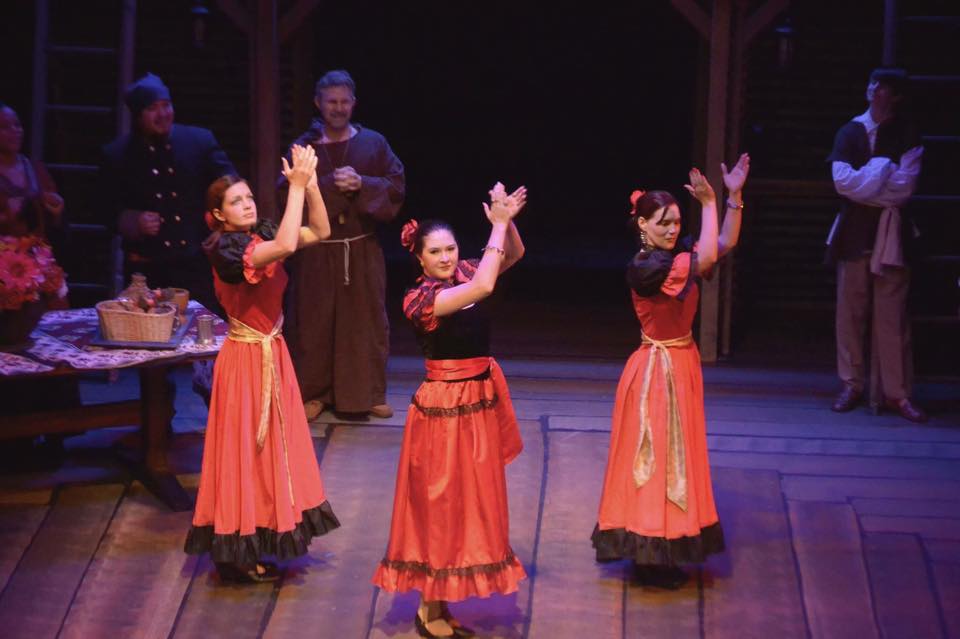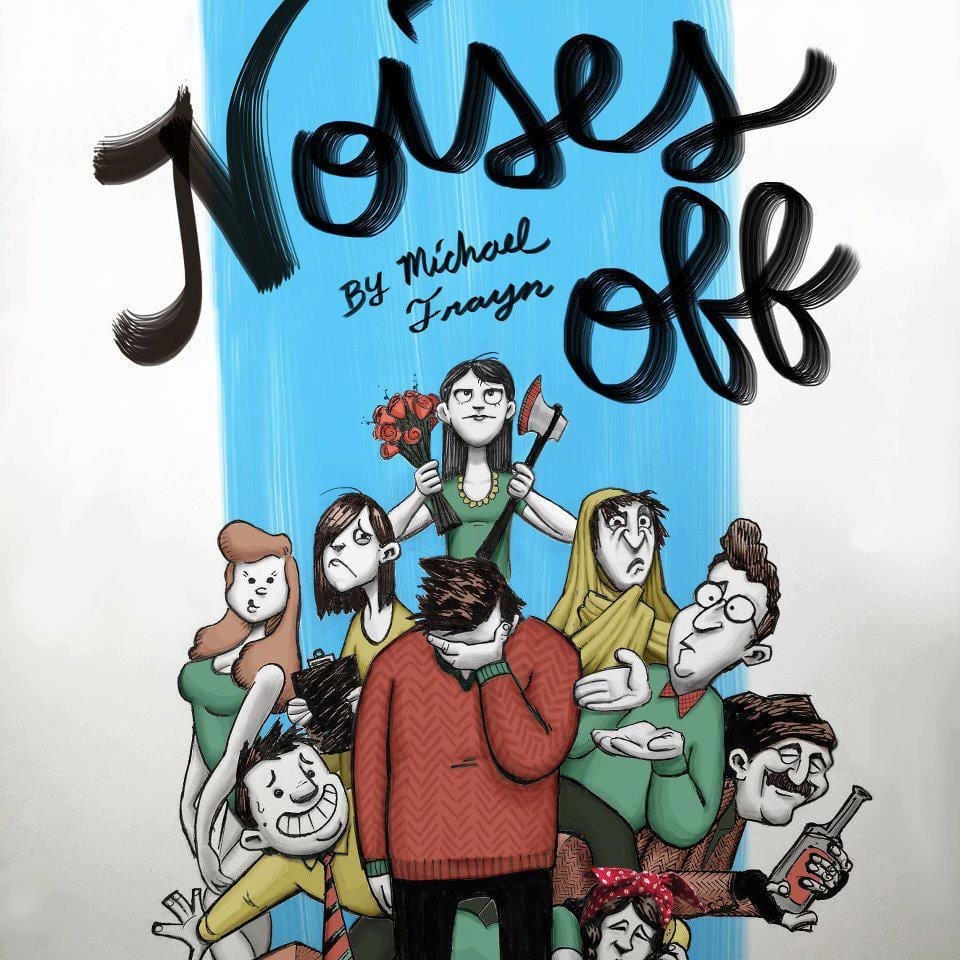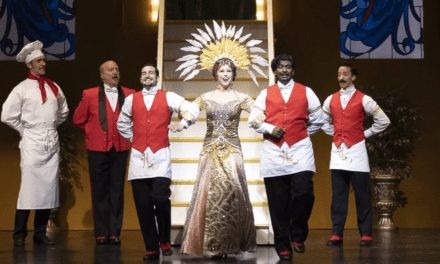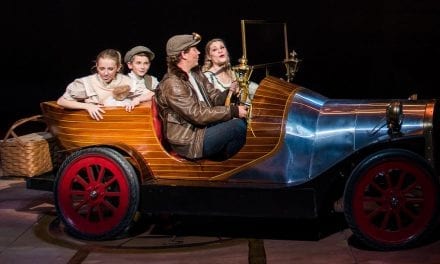SALT LAKE CITY — For nearly 100 years, audiences have been delighted by the stories of the legendary character Zorro, brought originally to life by author Johnston McCulley. Zorro has been the protagonist across nearly every media platform from books to movies and from television to live theater. In Joanne M. Parker‘s melodramatic stage adaptation titled Zorro!, the hero’s mask hides his true identity as Don Diego Vega, a nobleman in Old California, as he fights to free the territory from villains including Captain Ramon and Tuburcio Vasquez. With help from his mute assistant Bernardo, Zorro manages not only to evade the numerous and poorly executed plans of Sergeant Pedro Gonzales but also to win the heart of the beautiful Valencia Pulido and save Old California. To tell this story, the director, Emily Trulson Parker, wielded three powerful weapons including a creatively functional set design, intricate fight choreography, and a careful balance of comedic acting to access the most important element in the enjoyment of live theater: the imagination.
As I waited for the production to begin, I enjoyed examining James Parker‘s set design. The theater’s thrust stage had been painted to match the wood grain of an elevated section that protruded along the rear of the stage like a bridge, accessible from behind via stairs or from the front via wooden ladder. While I sat anticipating how the action might play out on this multilevel structure, I completely missed the set’s most versatile and exciting feature: a zip line running corner to corner above the stage. In fact, it wasn’t until actor Spencer Hohl made his speedy first entrance, flying straight into a blazing “Z” projected onto the back wall, that I noticed it at all. Throughout the show, Hohl was able to use it not only as a means of traveling above the stage, but also frequently descended by climbing down a rope dropped from the line. This made it possible for Zorro to drop onto nearly any part of the stage with sword and whip in hand. In addition, the actors’ athleticism and Parker’s direction combined to have actors creating entrances and exits wherever they saw fit. At one point, Bernardo (played by Jacob Harmon) simply jumped from the upper bridge down onto the main stage, while other actors could be seen scaling up or jumping down any accessible surfaces.
This good-versus-evil plot lent itself to frequent fights choreographed by Adam Argyle, which meant ample opportunities for the actors to show off their skilled swordsmanship. While I will admit to fast-forwarding through fight scenes and car chases on television, I was captivated by not only the required skills but the physical humor showcased in the many sword fights in this production. One early fight which took place in a tavern featured the heroic swordsman flinging mugs at his opponents by lifting the mug’s handle with the tip of the sword and then flinging it forward. Another involved the tips of several swords locked together in the center of a ring of fighters who turned in a synchronized circle as they fought. Words seem to dull the effect of the swordsmanship, which is likely why Parker’s script called for little to no dialogue for long stretches of the scenes; instead, the characters spoke with their swords. In the role of Zorro, however, Hohl had ample opportunity to speak instead with a whip. Rather than do his masterful manipulation of this weapon a disservice by attempting to describe it, I will say simply that had he been using the weapon in his dominant hand it would have been impressive, but Hohl often wielded the whip in his left hand while using the sword in the other. In these displays, Hohl lost none of the precision or crack he managed when the choreography allowed him to use his right hand.
 With so much of the plot unfolding to only the dialogue of clanking metal and cracking leather, Sergeant Pedro Gonzales (played by Oran Marc de Baritault) and his tendency to run at the mouth came as a welcome change of pace. With a perfect Spanish drawl that fell somewhere between drunk, lazy, and incompetent, and magnetic stage presence that overshadowed those with whom he shared scenes, de Baritault could nearly have convinced me to give up on the hero’s quest and rename the production Sergeant Gonzales. I particularly appreciated the many self-depreciating jokes about his weight and de Baritault’s willingness to go for the physical laugh. In a fight sequence late in the production, Gonzales finds himself atop the bridge with a sudden need to descend. However, a fear of heights prevents him from confidently boarding the ladder. He extended a hesitant toe in the ladder’s direction and cautiously pulled it back, only to extend and retract again. He finally managed to begin a rung-by-rung descent only to slip and find himself needing the assistance of a soldier below him whose duties apparently included extending his hands up to support the Sergeant’s hind quarters.
With so much of the plot unfolding to only the dialogue of clanking metal and cracking leather, Sergeant Pedro Gonzales (played by Oran Marc de Baritault) and his tendency to run at the mouth came as a welcome change of pace. With a perfect Spanish drawl that fell somewhere between drunk, lazy, and incompetent, and magnetic stage presence that overshadowed those with whom he shared scenes, de Baritault could nearly have convinced me to give up on the hero’s quest and rename the production Sergeant Gonzales. I particularly appreciated the many self-depreciating jokes about his weight and de Baritault’s willingness to go for the physical laugh. In a fight sequence late in the production, Gonzales finds himself atop the bridge with a sudden need to descend. However, a fear of heights prevents him from confidently boarding the ladder. He extended a hesitant toe in the ladder’s direction and cautiously pulled it back, only to extend and retract again. He finally managed to begin a rung-by-rung descent only to slip and find himself needing the assistance of a soldier below him whose duties apparently included extending his hands up to support the Sergeant’s hind quarters.
 Equally committed to the physical demands of his role was Jacob Harmon in the part of the mute assistant, Bernardo. Bernardo was required to deliver his fair share of the plot despite never speaking a word. Harmon accomplished this through the powerful gesticulations of not only his limbs, but also his hair. Although technically it was the muscles of his neck doing the work, Harmon’s hair seemed to tell the story on its own as it flopped out of and back into place again to accentuate the words he could not say aloud. By then end of the production, Harmon looked delightfully disheveled—his story all told. Additionally, while Hohl excelled in the physically demanding fighting requirements of Zorro, he also extracted his share of giggles as he played Don Diego Vega who, if not wholly whimpy, could at least be described as completely whiney. I was impressed by how even Hohl’s posture changed to fit the requirements of both characters.
Equally committed to the physical demands of his role was Jacob Harmon in the part of the mute assistant, Bernardo. Bernardo was required to deliver his fair share of the plot despite never speaking a word. Harmon accomplished this through the powerful gesticulations of not only his limbs, but also his hair. Although technically it was the muscles of his neck doing the work, Harmon’s hair seemed to tell the story on its own as it flopped out of and back into place again to accentuate the words he could not say aloud. By then end of the production, Harmon looked delightfully disheveled—his story all told. Additionally, while Hohl excelled in the physically demanding fighting requirements of Zorro, he also extracted his share of giggles as he played Don Diego Vega who, if not wholly whimpy, could at least be described as completely whiney. I was impressed by how even Hohl’s posture changed to fit the requirements of both characters.
Despite its fast pace and frequent action sequences, I would not describe this production as violent or frightening in any way. In fact, I think I laughed more than anything. The already easy to follow plot was accentuated by the melodramatic cheers and boos, alleviating any confusion that may have arisen from the large helping of Spanish vocabulary that peppered the dialogue. As is the case in many action shows, character and plot development may have occasionally taken a backseat to the action sequences. However, if your young audience favors action-packed cartoons, movies, or video games, they’ll probably enjoy a chance to watch it happen live at this Utah Children’s Theatre production of Zorro!






